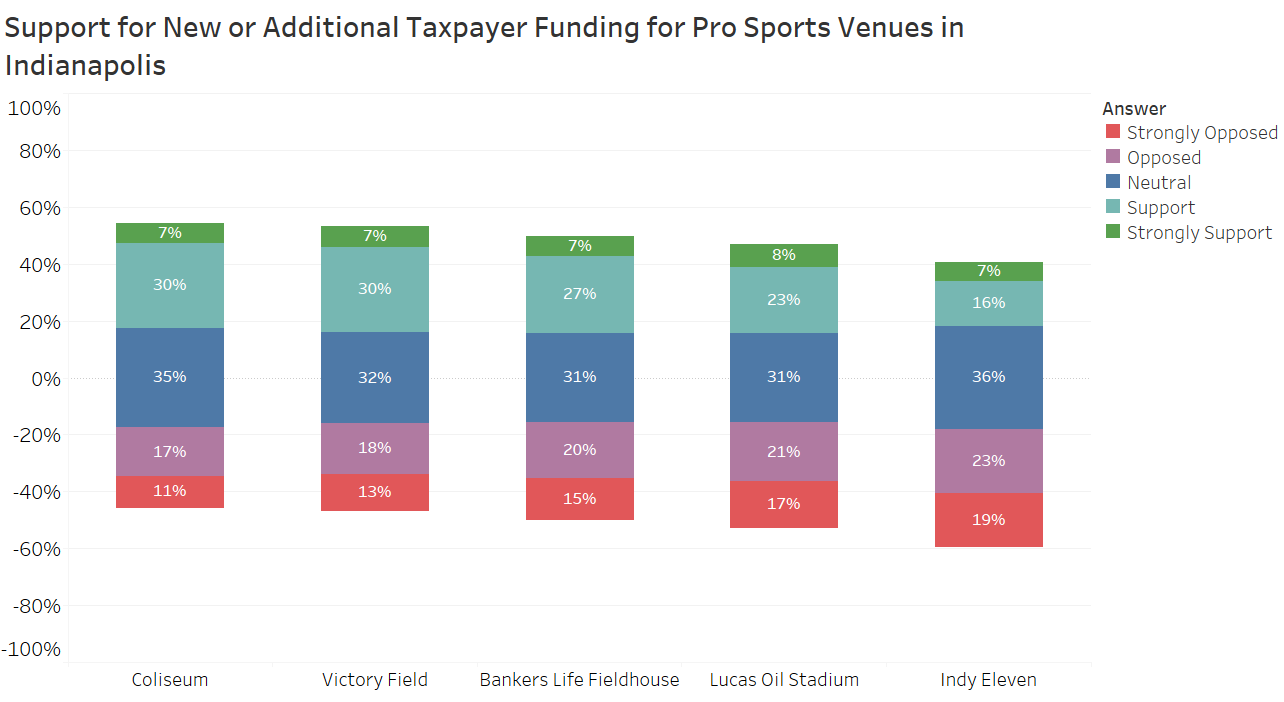Indy Sports Poll Results – Stadium Financing
In recent weeks, the Indy Eleven announced its latest pitch for a soccer-specific stadium as part of a $550 million development in Indianapolis after failing to receive legislative support on a funding initiative in 2015 and 2017.
Sen. Jack Sandlin (R-Indianapolis) introduced Senate Bill 543 to create a Professional Sports Development Area that captures $11 million annually in tax increment financing to pay off the bonds for the $150 million stadium. The remaining $400 million investment to create “Eleven Park” would come from private developers.
Three weeks before this announcement came out in early 2019, we surveyed 840 central Indiana residents on their opinion regarding using public taxpayer dollars to provide new or additional support for an Indy Eleven Stadium, in addition to Bankers Life Fieldhouse, Lucas Oil Stadium, the Indiana Farmers Coliseum at the Indiana State Fairgrounds, and Victory Field.
Here are three key takeaways from the data:
- There is tepid support for the use of public funds for a new soccer stadium for the Indy Eleven.
Only 23% of respondents supported the use of taxpayer funds for a new Indy Eleven stadium. This number significantly lagged behind support for the Coliseum and Victory Field (37%), Bankers Life Fieldhouse (34%), and Lucas Oil Stadium (31%).
When subtracting the percentage of those disapproving from those approving, a new Indy Eleven stadium recorded a -19% favorability rating, with 42% of respondents disapproving.
Favorability Ratings
- Coliseum (+9%)
- Victory Field (+6%)
- Bankers Life Fieldhouse (-1%)
- Lucas Oil Stadium (-7%)
- Indy Eleven (-19%)

- Democrats and Millennials show strongest levels of support.
Along political lines, Democrats showed the highest level of support for a soccer stadium at 27%, followed by 26% of Independents and 20% of Republicans. Those identifying as “Other” or “None” registered below 20%.
These numbers mirrored trends in how respondents answered poll questions about men’s professional soccer as a whole. Professional soccer was liked by 36% of Democrats, 33% of Independents, and only 18% of Republicans. Previous studies have found similar trends.
While there were differences in political affiliation, stadium funding debates can often blur traditional political lines and can even bring opposing sides to the same viewpoint. Liberal groups and free market advocates often end up opposing taxpayer backed corporate welfare projects for rich team owners. Additionally, Republican (Reagan) and Democrat (Obama) Presidents have attempted to push legislation to make it more difficult for teams to secure tax exempt bonds for stadiums.
Along generational lines, Millennials clearly showed the strongest support for a soccer stadium, followed distantly by Boomers and Gen X. The support for the stadium followed a similar trend as for the likeability of the team by generational group, as shown in the Table below. Stronger support and interest by Millennials has been found in other national polls in recent years.
Generation | Support New Stadium | Oppose New Stadium | Like Indy Eleven | Dislike Indy Eleven |
Millennial | 31% | 31% | 37% | 20% |
Baby Boomer | 19% | 50% | 20% | 20% |
Gen X | 18% | 40% | 24% | 20% |
- Given the tepid support for a publicly funded stadium, the more private and the less public the partnership, the more palatable it will be to legislators.
The poll results do not bode well for another trip to the legislature to seek taxpayer funds for an $85-$100 million stadium like the team attempted in 2015 and 2017. This time, the Indy Eleven strategy to predominantly shield taxpayers from the burden of funding the $150 million stadium through sales and tourist taxes, but, instead, through tax increment financing (TIF) in a sports development district will play better at the Statehouse. The remaining $400 million project surrounding the stadium to include office space, retail shops, apartments, and a hotel would come from private investment, allowing the Eleven to strategically and wisely position the project as a private-public partnership.
TIF districts are used by cities to pay for infrastructure needed to promote economic development. The district captures the increase in assessed property value and allocates the incremental tax revenue toward the repayment of the bond used to pay for the construction. One of the key advantages to the use of TIF in Indiana is it does not need to be approved by voters at the ballot box in a referendum.
Indiana law requires there to be evidence the development would not happen but for the establishment of the TIF district (“but for test”). For the TIF district to be approved by the legislature, there needs to evidence the development would not happen but for the establishment of the TIF district. Examination of the six sites discussed in a recent Indianapolis Business Journal article are logical and make sense given the “but for test” requirement that was adopted into Indiana law in 2014. For a full treatment the usage of TIF districts in Indiana, check out the work by Larry DeBoer at Purdue University and Mike Hicks and Ball State University.
Indy Sports Poll Respondent Characteristics
Take a look at the demographic characteristics of the survey respondents.
Ethnicity: 84% white; 9% black
Gender: 48% male; 52% female
Political Party: 36% Republican; 28% Democrat; 22% independent; 11% None; 3% Other
Residence: 42% Marion County; 36% Donut County; 22% Indiana county not bordering Marion
Where did you grow up? 67% in central Indiana; 33% somewhere else
Income: 40% less than $50K; 39% between $50 and $100K; 21% $100K+

